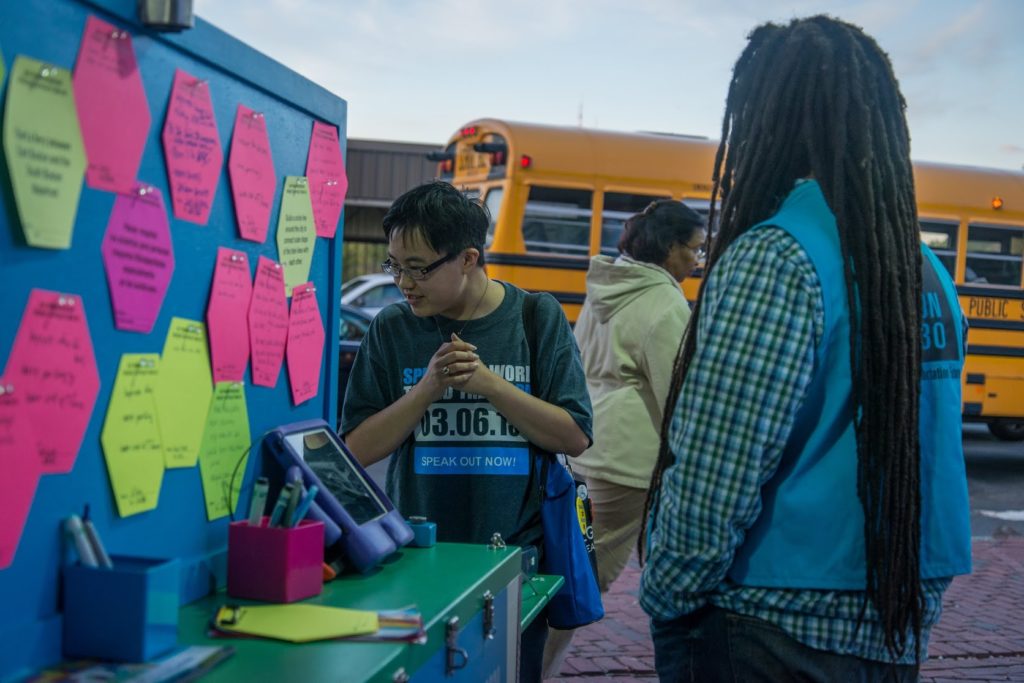By Sam Haas, city editor
If Bostonians have their way, shorter and cheaper commutes, safer streets, abundant car-sharing locations, bike paths throughout the city and an environmentally-friendly transit system will form the backbone of Boston’s transportation future.
The Boston Transportation Department (BTD) solicited these and other ideas from residents at daily, public, outdoor conversations in 31 neighborhoods from Sept. 19 to Oct. 21. The conversations were part of BTD’s Go Boston 2030 program, which is in the process of creating a transportation plan for the city.
Go Boston 2030 began collaborating with residents in January by dispatching a question truck to ask broad questions about transportation in various neighborhoods, according to Alice Brown, the project manager. Her team used answers to those questions, along with ideas gathered from over 6,000 people during a two-day “Visioning Lab” in May, to release a draft framework of goals and targets earlier this fall.
“Affordability, reliability and safety became the themes running throughout the things we’ve done since,” Brown said. “[The interaction] has been a way to empower, to build the political capital to be able to say, ‘This is what people really want.’”
“We really want to hear from people about what their vision is for mobility for the next 15 years and beyond,” BTD Commissioner Gina Fiandaca said. “The process has been really rewarding as we flesh out the competing interests and work towards a unified vision of the future.”
Questions of access and price featured prominently at a pop-up conversation at the Dudley Square Farmer’s Market in Roxbury on Oct. 15. On fluorescent sticky notes, participants called for buses to “stick to the departure time,” for the city to “build a parking garage down Dudley [Street] for all” and for providers to “make everything more affordable.”
Residents also hope the city will address commute time, according to Brien Tal-Baker, 34, of Roxbury.
“My idea is to make it so you can get bikes on the T during rush hour,” Tal-Baker said. “To go from one end of the system to another, you just can’t get there easily – which makes it hard to get to jobs.”
Expanding economic opportunity and equitable access are two of the city’s chief goals for the project, according to the draft framework. Due to a lack of nearby transit options for people in Roxbury, Dorchester, Mattapan, East Boston and other neighborhoods outside the city center, people in those areas must spend more time and money navigating the city. That burden makes it difficult for some people to find employment.
“As more jobs move out of the downtown core but remain in the city, we want people to be able to access those,” Brown said.
Other goals include eliminating traffic fatalities, automating lights at all intersections to respond to usage patterns in real-time and spreading bike-share and car-share services more evenly throughout the city.
Improving Boston’s transit system is necessary to ensure it can continue to adequately meet people’s needs, according to Ann Phung, a senior pharmacy major at Northeastern University.
“It would be great if there could be a better balance between cost and efficiency,” Phung said. “I hope it’s more streamlined and more reliable [in the future]. Luckily I was on campus last winter, but I kept thinking, ‘What if I had to go to work? How would I get there?’”
Incorporating citizens’ ideas into improvements is a valuable step, Phung added, though experts should still play a role in the planning.
“The city knows what’s feasible, while people may not have a way to do a solution they have in mind,” Phung said. “Still, public transportation is for the people, so you should listen to them.”
While planning is ongoing, not every change is coming years down the road: BTD is currently implementing several changes to city infrastructure, according to Fiandaca.
“It’s very much a dynamic process,” Fiandaca said.
These initiatives, collectively referred to as “Early Action Projects,” touch on a variety of issues. One of the most important is bike safety, which city officials are addressing with the Vision Zero project. Announced in March – and pursued with renewed urgency following the August death of cyclist Anita Kurmann – Vision Zero aims to reduce traffic deaths.
“We’re utilizing some data from EMS and the Boston Police Department to identify high-risk intersections within the city and see what we can do to improve those locations now,” Fiandaca said.
Other early-action projects include efforts to expand green spaces within Boston and the installation of “smart meters” capable of accepting payment via smartphone, credit card or coins. The new meters also collect and transmit usage data, according to the Go Boston 2030 report.
Go Boston 2030 and BTD officials will continue to solicit Bostonians’ thoughts at three community roundtable events in November, Fiandaca said. The group is on track to release its finalized action plan next spring.
For that plan to best serve Boston, residents and planners must continue to share ideas, according to Tal-Baker.
“With any change, it’s key to have community buy-in,” Tal-Baker said. “That’s partially the responsibility of the people running things, but also partially the responsibility of the public.”
Brown agreed, citing the importance of talking and listening to people who might otherwise be excluded from discussions about the city’s future.
“In most traditional processes, we have a pretty fully-baked idea and people just come out to say no to it,” Brown said. “We’re trying to talk to people before that step – to really have a dialogue. We want to do this right.”
Photo by Scotty Schenck









